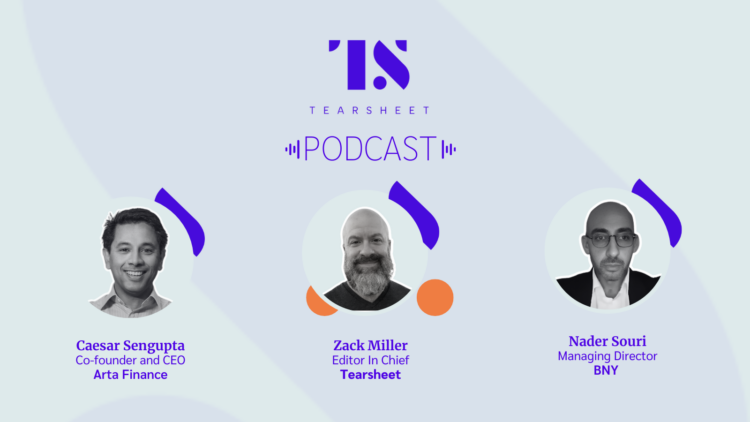Tearsheet’s roots were in investment and wealth tech. As that world became more focused on plain vanilla robo-advisors about a decade ago, I expanded our focus to include banking, payments, and lending. That’s because with ETFs and low-cost providers, it felt like most of the focus of innovation was coming from removing costs.
Things have changed since then. On today’s episode, we explore the changing world of wealth management with two industry leaders: Nader Souri, Head of Corporate Banking at BNY, and Caesar Sengupta, CEO of Arta Finance. You don’t have to listen closely to really feel their connection and the relationship they’ve personally forged through working together. I first spoke with Ceasar a few years ago when he was VP and General Manager of Payments and Next Billion Users at Google.
Our conversation reveals how these two organizations are leading how wealth management solutions are evolving for professionals. It also sheds light on the role of fintech partnerships in this transformation.
Caesar Sengupta opens the discussion by explaining Arta Finance’s mission. “We are a digital family office or a digital private bank for professionals, not the ultra-rich,” he says. The goal is to democratize wealth management and make sophisticated financial tools accessible to those who have worked hard in their careers. Nader Souri adds, “At BNY, we provide the platform upon which folks like Arta Finance can build their businesses.” He highlights the role of clearing and custody infrastructure. This helps in supporting innovative fintech solutions.
The Genesis of a Strategic Partnership
Nader Souri recounts the origins of the partnership between BNY and Arta Finance. “We have a history of working with fintechs and other advisory firms, both on the traditional and non-traditional side,” he notes. The shared vision of improving the user experience in wealth management drives the collaboration with Arta Finance. Sengupta emphasizes the importance of reliability and trust in choosing a partner. He states, “We wanted to provide that assurance to our members that their assets are safe.”
Technical Excellence and Innovation
One of the standout features of Arta Finance’s offering is its technical sophistication. Caesar Sengupta elaborates, “We use technology to bring the same kind of services that a private bank would offer to high net worth individuals, but to people with hundreds of thousands to a few million dollars.” This includes advanced investment strategies such as direct indexing with tax loss harvesting. This was available only to the ultra-wealthy before.
Navigating Regulatory Landscapes
Both Sengupta and Souri stress the importance of understanding and navigating regulatory requirements. Souri explains, “You have to work within regulatory guidelines, and that’s different from coming from an unregulated industry.” Sengupta appreciates BNY’s guidance in this area. He says, “A big part of it is also helping us understand and set expectations correctly.”
The Big Ideas
- Sengupta’s vision for Arta Finance is to make sophisticated wealth management tools accessible to a broader audience. “We believe we can unlock the same financial superpowers that the ultra-wealthy have had all this while,” he says.
- Souri highlights the importance of strategic partnerships in the FinTech space. “You have to be cautious on who you want to partner with, but when the mission aligns, it makes a ton of sense,” he notes.
- Arta Finance leverages advanced technologies to enhance wealth management. Sengupta explains, “We now do direct indexing with tax loss harvesting at a minimum of $25,000, making it accessible to more people.”
- Both leaders emphasize the need for compliance in regulated financial services. Souri states, “Resiliency is key, and being resilient isn’t just about having a strong financial position but also having the right regulatory and compliance procedures.”
- The partnership aims to provide a comprehensive wealth management solution. “This is not just another wealth management offering in a digital wrapper,” says Souri. “It’s a holistic offering that even goes beyond what BNY offers.”
Listen to the full episode












